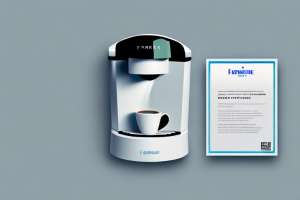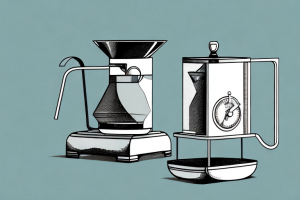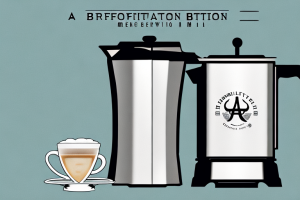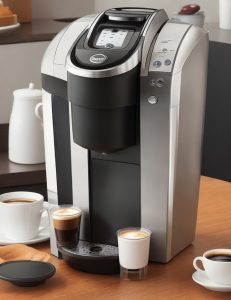How To Make Coffee In A Cuisinart Coffee Maker

A cuisinart coffee maker with coffee beans and a cup of coffee beside it
If you’re looking for a reliable coffee maker that can give you a fresh cup of coffee anytime you want, then a Cuisinart coffee maker might be the perfect choice for you. These coffee makers are popular for their brewing precision, ease of use, and versatility. Here’s a comprehensive guide on how to use your Cuisinart coffee maker to make delicious coffee that satisfies your taste buds.
Getting Started: Assembling Your Cuisinart Coffee Maker
The first step towards brewing delicious coffee in your Cuisinart coffee maker is to properly assemble your machine. Start by unpacking the parts and accessories that come with your machine and then assemble them according to the manufacturer’s instructions. Make sure that you understand how your machine works before you start brewing your coffee.
It is important to note that not all Cuisinart coffee makers are assembled in the same way. Some models may have additional parts or require different assembly steps. Always refer to the instruction manual that comes with your specific model to ensure proper assembly and avoid any potential damage to your machine. Once your machine is properly assembled, you can begin experimenting with different coffee blends and brewing techniques to find the perfect cup of coffee for you.
Choosing the Right Coffee Beans and Grind for your Cuisinart Coffee Maker
If you want your coffee to taste great, then choosing the right coffee beans and grind is crucial. Freshly roasted coffee beans can make a great difference in the aroma and taste of your coffee. You can also experiment with different types of coffee beans to find the one that you like the most. As for grind size, choose a coarse grind for an automatic drip coffee maker like Cuisinart, as fine grinds may clog the filter and result in a weaker coffee.
Another important factor to consider when choosing coffee beans is the roast level. Lighter roasts tend to have a more acidic and fruity flavor, while darker roasts have a bolder and more robust taste. It’s all a matter of personal preference, so don’t be afraid to try different roast levels to find the one that suits your taste buds.
It’s also important to store your coffee beans properly to maintain their freshness. Keep them in an airtight container away from light, heat, and moisture. Avoid storing them in the fridge or freezer, as the moisture can cause the beans to deteriorate quickly. By following these tips, you can ensure that your coffee always tastes fresh and delicious.
Water Matters: Tips for Using the Right Water in Your Cuisinart Coffee Maker
Water quality affects coffee taste. Use fresh and cold tap water, and always replace the water in your machine after a brewing cycle to avoid any lingering flavors. We recommend against using hard water as it contains minerals that can interfere with the taste of your coffee.
Additionally, it is important to note that using distilled or purified water may not be the best option for your coffee maker. These types of water lack the minerals that are necessary for optimal coffee extraction and can result in a flat or dull taste. It is best to use water that has a balanced mineral content for the best tasting coffee.
How to Measure Coffee Grounds: Dos and Don’ts
Measuring the right amount of coffee grounds is important to achieve the right strength and taste of your coffee. A general rule of thumb is two tablespoons of coffee per six ounces of water. You can increase or decrease this amount depending on your preference.
However, it’s important to note that the type of coffee you use can also affect the measurement. For example, if you’re using a darker roast, you may need to use slightly less coffee grounds to avoid an overpowering taste. On the other hand, a lighter roast may require slightly more coffee grounds to achieve the desired strength. It’s always a good idea to experiment with different measurements and types of coffee to find the perfect balance for your taste buds.
Using the Right Filter: Paper or Permanent Filter?
Cuisinart coffee makers work with both paper and permanent filters. Paper filters can deliver a clean cup of coffee with a light body, while permanent filters are more eco-friendly and allow for more oils and flavors to pass through. It’s up to your preference which one to use
However, it’s important to note that using a permanent filter requires more maintenance. The filter needs to be cleaned regularly to prevent buildup and ensure the best flavor in your coffee. On the other hand, paper filters can be easily disposed of after each use, making cleanup a breeze. Consider your lifestyle and priorities when deciding which filter to use in your Cuisinart coffee maker.
Prepping Your Cuisinart Coffee Maker for Brewing: Cleaning and Maintenance Tips
To ensure your coffee maker stays clean and operates at optimal performance, clean your Cuisinart machine after every few cycles of use. Use vinegar or specialized descaling solution and run it through the machine to remove any mineral buildup. Before brewing coffee, make sure to preheat your machine and discard any excess water in the reservoir to avoid producing a cold or weak coffee.
Additionally, it is important to regularly replace the water filter in your Cuisinart coffee maker. The water filter helps to remove impurities and improve the taste of your coffee. Check the manufacturer’s instructions for the recommended frequency of filter replacement, and be sure to purchase the correct replacement filter for your specific model of Cuisinart coffee maker.
Brewing Your First Cup of Coffee in a Cuisinart Coffee Maker: Step-by-Step Guide
Once you’ve done the prep work, it’s time to start brewing your coffee. Fill the water reservoir to the desired level, place a filter with the coffee grounds, and close the basket. Finally, turn on the machine and let it work its magic. Always refer to the instruction manual for the recommended brewing time and temperature settings for your coffee maker and choose the strength that’s right for your preferences.
One important thing to keep in mind when brewing coffee in a Cuisinart coffee maker is to use high-quality coffee beans. The quality of the beans can greatly affect the taste of your coffee. It’s also recommended to grind your own beans for the freshest flavor.
After brewing your coffee, make sure to clean your coffee maker regularly to ensure it continues to function properly. This includes regularly descaling the machine and cleaning the carafe and filter basket. By taking care of your coffee maker, you can enjoy delicious coffee for years to come.
Adjusting the Strength of Your Brew in a Cuisinart Coffee Maker
If you want a stronger cup of coffee, you can generally increase the amount of coffee grounds you use or choose a longer brewing time. Conversely, for a weaker coffee, you can decrease the amount of coffee grounds you use or opt for a shorter brewing time. You can experiment to find out how to make coffee just the way you like it.
It’s important to note that the type of coffee beans you use can also affect the strength of your brew. Darker roasts tend to have a stronger flavor, while lighter roasts are milder. Additionally, the grind size of your coffee can impact the strength of your brew. Finer grinds will result in a stronger cup, while coarser grinds will be weaker. Keep these factors in mind as you adjust the amount of coffee grounds and brewing time to achieve your desired strength.
Using the Programmable Features of Your Cuisinart Coffee Maker to Make Customized Cups of Joe
Cuisinart coffee makers come with advanced programmable features that let you customize your coffee making experience. From automatic shut-off, brew pause and adjustable brew strength control, Cuisinart offers a range of convenient features that allow you to tailor your coffee to your preference.
One of the most useful programmable features of Cuisinart coffee makers is the ability to set a timer for your coffee to start brewing. This means that you can wake up to the smell of freshly brewed coffee, or have a pot ready and waiting for you when you get home from work. Additionally, some models even come with a hot water dispenser, allowing you to make tea or hot cocoa with ease. With all of these customizable options, your Cuisinart coffee maker is sure to become your go-to appliance for your morning caffeine fix.
How to Keep Your Cuisinart Coffee Maker Clean and Fresh Between Uses
Cleaning your coffee maker is essential for keeping it fresh and hygienic. Always make sure to discard leftover coffee and rinse the carafe and other parts with warm soapy water. Use a cloth to wipe the exterior of the machine, and regularly descale it to prevent mineral buildup that can affect the taste of your coffee. Store the machine in a dry and clean place away from direct sunlight or heat sources.
Another important step in keeping your Cuisinart coffee maker clean is to regularly replace the water filter. This will help remove impurities and improve the taste of your coffee. You can easily find replacement filters at most grocery stores or online.
If you notice that your coffee maker is not brewing as quickly as it used to, it may be time to deep clean the machine. This involves running a mixture of water and vinegar through the machine to remove any buildup or clogs. Be sure to consult your user manual for specific instructions on how to deep clean your Cuisinart coffee maker.
Troubleshooting Common Issues with a Cuisinart Coffee Maker
If you experience any issues with your Cuisinart coffee maker, such as slow or incomplete brewing, weak or bitter coffee, machine not turning on, or noise during operation, try some basic troubleshooting steps from the manufacturer’s instruction, such as cleaning the machine or resetting it to factory settings. If problems persist, contact the customer support team or refer to the warranty policy.
By following these tips, you’ll be able to enjoy a great cup of coffee from your Cuisinart coffee maker every time.
It’s important to note that using the wrong type of coffee grind can also cause issues with your Cuisinart coffee maker. Make sure to use the appropriate grind for your machine, as specified in the instruction manual. Using too fine of a grind can result in clogging and slow brewing, while using too coarse of a grind can lead to weak coffee. By using the correct grind, you can ensure optimal performance from your Cuisinart coffee maker.



